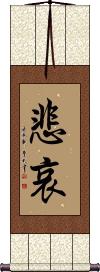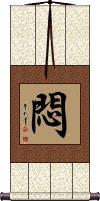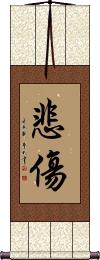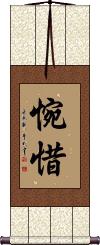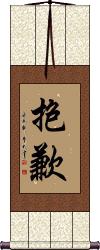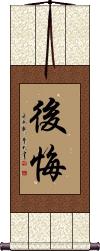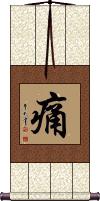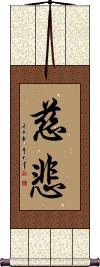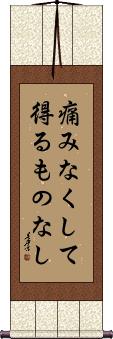Many custom options...
And formats...

Sorrow in Chinese / Japanese...
Buy a Sorrow calligraphy wall scroll here!
Personalize your custom “Sorrow” project by clicking the button next to your favorite “Sorrow” title below...
5. Sorry / Feel Apologetic / Regret
6. Sorry / Apologetic / Repent / Regret
7. Pain
Sadness / Sorrow
悲哀 means grieved, sorrowful, sorrow, grief, and sadness in Chinese, old Korean Hanja, and Japanese Kanji.
In the Buddhist context, it suggests the kind feeling in your heart toward others (as the result of feeling sorrow).
Note: This is a strange selection for a calligraphy wall scroll.
Melancholy / Sorrow
悶 is a character that can mean melancholy, sorrow, or depression.
The visual meaning depicts a heart shut behind a door or gate. In some contexts outside of melancholy, this can mean sealed, airtight, or shut indoors.
This sad or sorrowful character is kind of a strange selection for a calligraphy wall scroll.
Sadness / Sorrow
Sorrow / Feeling Sorry
Sorry / Feel Apologetic / Regret
Sorry / Apologetic / Repent / Regret
後悔 is the feeling of being or feeling repentant, apologetic, and regret.
後悔 is not sorrow.
This term is often used in the context of Buddhism and other religions.
Note: This is a strange thing to write on a wall scroll for Chinese, Japanese, and Korean people - but you can bend the rules if you want in the west.
Pain
ache / sorrow
痛 means pain in Chinese and old Korean Hanja. It also means pain/hurt/bruise in Japanese but is seldom seen as a single Kanji (usually, at least a Hiragana is added to make the word “itai” which is what a Japanese person will scream when they are in pain).
Depending on the context, this word can mean hurt, ache, sorrow, or refer to damage to a human body. As a single character, the possible meanings are very open - so you can decide what it means to you, as long as the general meaning is still “painful.”
See Also: Hurt
Mercy / Compassion / Buddhist Loving Kindness
Besides the title above, 慈悲 can also be defined as clemency or lenience and sometimes the act of giving charity.
In the Buddhist context, it can be defined as “benevolence,” “loving-kindness and compassion,” or “mercy and compassion.”
This Buddhist virtue is perhaps the most important to employ in your life. All sentient beings that you encounter should be given your loving kindness. And trust me, however much you can give, it comes back. Make your life and the world a better place!
This Chinese/Japanese Buddhist term is the equivalent of Metta Karuna from Pali or Maitri Karuna from Sanskrit.
慈 can mean loving-kindness by itself.
悲 adds a component of sorrow, empathy, compassion, and sympathy for others.
See Also: Benevolence
No Pain No Gain
痛みなくして得るものなし is a Japanese phrase that means “no pain, no gain.”
This suggests that with pain, a gain must follow.
The pain Kanji here can also be translated as sorrow or suffering. The gain can also mean profit, advantage, or benefit. In the Japanese Buddhist context, that gain Kanji can mean rebirth in paradise, entering nirvana.
The character breakdown:
痛みなく (itami naku) pain; ache; sore; grief; distress. The naku part adds the meaning of “a lot of” or “extended”
して (shite) and then. (indicates a causative expression; acts as a connective particle)
得る (eru) to get; to acquire; to obtain; to procure; to earn; to win; to gain; to secure; to attain.
もの (mono) conjunctive particle indicating a cause or reason.
なし (nashi) none of; -less; without; no.
Note: Because this selection contains some special Japanese Hiragana characters, it should be written by a Japanese calligrapher.
These search terms might be related to Sorrow:
Die Without Regret
Live Without Regret
No Trouble / Freedom From Problems
Sadness / Sorrow
Sorry / Apologetic / Repent / Regret
Sorry / Feel Apologetic / Regret
The following table may be helpful for those studying Chinese or Japanese...
| Title | Characters | Romaji (Romanized Japanese) | Various forms of Romanized Chinese | |
| Sadness Sorrow | 悲哀 | hi ai / hiai | bēi āi / bei1 ai1 / bei ai / beiai | pei ai / peiai |
| Melancholy Sorrow | 悶 闷 | mon | mèn / men4 / men | |
| Sadness Sorrow | 悲傷 悲伤 | hi shou / hishou / hi sho | bēi shāng bei1 shang1 bei shang beishang | pei shang peishang |
| Sorrow Feeling Sorry | 惋惜 | wàn xí / wan4 xi2 / wan xi / wanxi | wan hsi / wanhsi | |
| Sorry Feel Apologetic Regret | 抱歉 | bào qiàn / bao4 qian4 / bao qian / baoqian | pao ch`ien / paochien / pao chien | |
| Sorry Apologetic Repent Regret | 後悔 | kou kai / go ke koukai / goke ko kai / go ke | hòu huǐ / hou4 hui3 / hou hui / houhui | |
| Pain | 痛 | tsuu / ita / tsu / ita | tòng / tong4 / tong | t`ung / tung |
| Mercy Compassion Buddhist Loving Kindness | 慈悲 | ji hi / jihi | cí bēi / ci2 bei1 / ci bei / cibei | tz`u pei / tzupei / tzu pei |
| No Pain No Gain | 痛みなくして得るものなし | itami naku shite erumono wa nashi | ||
| In some entries above you will see that characters have different versions above and below a line. In these cases, the characters above the line are Traditional Chinese, while the ones below are Simplified Chinese. | ||||
Successful Chinese Character and Japanese Kanji calligraphy searches within the last few hours...
